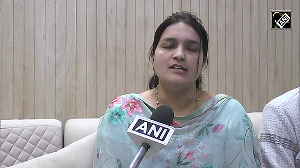With private and foreign banks scaling down their lending activity and equity and overseas sources of capital drying up, the total flow of resources to the commercial sector has dropped by nearly 20 per cent till the end of February.
According to estimates, private banks have seen the year-on-year growth in credit flow drop from around 28.5 per cent in October 2008 to a shade above 5 per cent at the end of February. Similarly, foreign banks have also seen the growth rate decline from 20.2 per cent to 8.1 per cent during the period. In contrast, public sector banks have seen the growth rate drop from 27.5 per cent to around 26 per cent.
The numbers indicate a further deceleration in lending activity compared with the start of January, when the year-on-year growth for private banks was 11.8 per cent and 16.9 per cent for foreign banks.
According to the latest data released by the Reserve Bank of India (RBI), up to January 2, 2009, the flow of financial resources to the commercial sector was estimated at Rs 4,84,713 crore (Rs 4847.13 billion), as against Rs 4,99,484 crore (Rs 4994.84 billion) as on January 4, 2008, which represented a decline of 2.96 per cent.
On the deposit side, though the latest estimates were unavailable, depositors have preferred public sector banks, which saw fund mop up during the year up to January 2, 2009 stay at 24.2 per cent.
Foreign banks saw the growth rate drop to 12.1 per cent during the year up to January 2, 2009, as against 34.1 per cent in the corresponding period last year. Similarly, for private banks, on a year-on-year basis, the growth rate fell to 11.8 per cent from 26.9 per cent, according data released by RBI in third quarter review of the monetary policy.
With public sector raising deposits at higher costs, depositors - both companies and individuals opted for government banks, which were also seen to be safer given the global financial turmoil. "In this market, if you can hold on to the deposit base, it is an achievement," said the head of a small private sector bank.
As a result of lower growth in deposit mobilisation, private and foreign banks have been unable to substitute the high cost funds they had raised in previous years and that is seen as one of the reasons for them to go slow reducing lending rates.
In any case, lenders such as ICICI Bank have slowed down sanctioning fresh loans fearing default, while others such as Development Credit Bank have been forced to deal with higher delinquencies and are clearing very few loan proposals. "It is the withdrawal of ICICI Bank which is really affecting the growth numbers," said a bank executive.
At the same time, lenders such as HDFC Bank and Axis Bank have slowed down their lending marginally and executives at the two banks said that a part of the reason was lower demand from companies and individuals.
AMONG foreign banks, the three major players - Citi, Standard Chartered and HSBC - too have slowed down activity. Banks such as Citi and ABN Amro have disclosed that during the October-December quarter, the rise in delinquencies in the retail book in India was among the highest globally.
Apart from access to bank loans and investments, fund flow through other avenues has also dropped. Flow of resources from the commercial sector consists of equity, foreign currency convertible bonds, external commercial borrowings, Global and American Depository Receipts (GDRs and ADRs) and foreign direct investment (FDI).
According to the latest RBI data, FDI inflows rose 13.11 per cent to $27.43 billion during April-January 2008-09, as against $24.25 billion during the corresponding period last year.
But on most other fronts, there was a decline of flows to the corporate sector. For instance, according to Prime Database, companies have raised Rs 2,034 crore (Rs 20.34 billion) during the financial year up to February, as against Rs 37,302 crore (Rs 373.02 billion) during April-February 2007-08 - a drop of 94.55 per cent.
Similarly, during the period, mop-up through the rights issue route fell by around 11 per cent to Rs 11,982 crore (Rs 119.82 billion), as against Rs 13,447 crore (Rs 134.47 billion) last year.
Of the funds raised through this route, over Rs 9,000 crore (Rs 90 billion) were raised by Tata Motors (Rs 4,415.81 crore) and Hindalco (Rs 5,047.70 crore) and both of them devolved on the underwriters due to the adverse market conditions.
The story was much the same in case of funds accessed from through ADRs and GDRs, with companies raising around Rs 1,200 crore (Rs 12 billion) during April-February, as against Rs 74,050 crore (Rs 740. 50 billion) during the same period last year.
Following the Lehman collapse in September, companies have also found it difficult to raise funds overseas through external commercial borrowings and foreign currency convertible bonds as the cost of funds have gone up.
In addition, Indian companies have also put their expansion plans on the backburner due to lower demand in the domestic and overseas markets. Indian companies raised $16.80 billion via ECBs and FCCBs during April-January as against $25.62 billion during the same period last year, a fall of 34.43 per cent.







 © 2025
© 2025